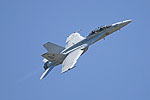US Navy Flight Testing Distributed Targeting System for Super Hornet
 CHINA LAKE, Calif., Sept. 2, 2010 – The Boeing Company [NYSE: BA] and the U.S. Navy’s Air Test and Evaluation Squadron VX-31 have begun flight testing a Distributed Targeting System for the F/A-18E/F Super Hornet strike fighter at the Naval Air Warfare Center Weapons Division Advanced Weapons Lab in China Lake. The current test phase is scheduled to conclude in November 2011.
CHINA LAKE, Calif., Sept. 2, 2010 – The Boeing Company [NYSE: BA] and the U.S. Navy’s Air Test and Evaluation Squadron VX-31 have begun flight testing a Distributed Targeting System for the F/A-18E/F Super Hornet strike fighter at the Naval Air Warfare Center Weapons Division Advanced Weapons Lab in China Lake. The current test phase is scheduled to conclude in November 2011.
The Distributed Targeting System uses onboard hardware and software processing to produce precise targeting solutions for Super Hornet aircrews. This enhanced targeting capability is part of the Navy’s F/A-18E/F Network Centric Warfare Upgrades program as well as the F/A-18E/F Flight Plan, which ensures that the Super Hornet remains ahead of known and emerging threats throughout the coming decades.
“Distributed Targeting will continue to expand the Super Hornet’s already advanced multirole capability for the warfighter,” said Kory Mathews, F/A-18 and EA-18 Programs vice president for Boeing. “Distributed Targeting is a powerful tool that will provide Super Hornet aircrews with highly precise targeting capability when identifying and engaging ground target sets. This is another phase of our evolutionary approach to continuous capability enhancement for the Navy’s combat-proven Super Hornet.”
Successful completion of the flight tests will enable the targeting system to transition to operational testing in late 2011. The capability is expected to become operational in F/A-18E/F aircraft in 2012.
The Boeing Super Hornet is a multirole aircraft, able to perform virtually every mission in the tactical spectrum, including air superiority, day/night strike with precision-guided weapons, fighter escort, close air support, suppression of enemy air defenses, maritime strike, reconnaissance, forward air control and tanker missions. Boeing has delivered more than 430 F/A-18E/Fs to the U.S. Navy. Every Super Hornet produced has been delivered on or ahead of schedule and on budget.